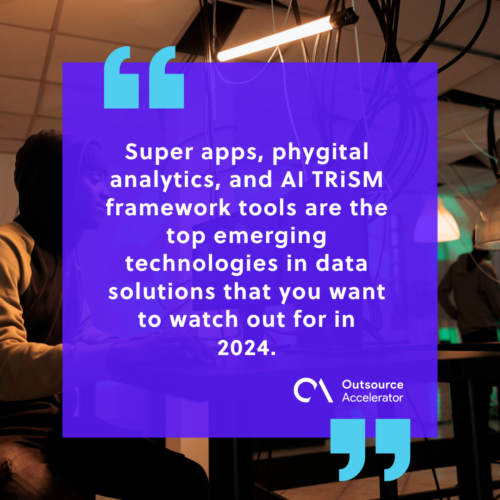Emerging data solutions technologies in 2024

This article is a submission by SG Analytics. SG Analytics is a global insights and analytics company that focuses on ESG, data analytics, and investment & market research services.
Stakeholders can fulfill the promise of continuous business improvement for disruptive innovation by supporting the evolving data management and value creation applications.
Thankfully, talented minds worldwide have contributed to advanced research and development (R&D) initiatives, open source or otherwise.
This post will celebrate the most versatile emerging technologies redefining modern data solutions in 2024 and beyond.
Importance of consistent data systems upgrades
Legacy tools undermine productivity due to software and hardware bottlenecks. Meanwhile, cybercriminals love individuals and organizations who irresponsibly delay tech updates.
Amid the rise of automated ransomware and identity theft attacks, stakeholders must guard their data from unwarranted surveillance by private and public sector entities.
Therefore, newer technologies complying with a balanced approach to cybersecurity, ease of use, privacy, and legitimate information processing norms are essential to the future of data operations in this era of 360-degree digital transformation.
Older programs are also inadequate if businesses want to optimize resource consumption and take advantage of cloud-first platform integrations for modernization.
Investing in robust AI projects for insight discovery and streamlined workflows is nonnegotiable if an enterprise wants to automate operations for a competitive edge.
After all, your business rivals have already adopted some of these data technologies. They might increase employee productivity, resilience against security threats, and regulatory data protection compliance.

3 emerging data solutions technologies
Watch out for these three data solutions technologies businesses must incorporate into their systems this 2024:
1. Super apps and data connectors
Specialized product development is excellent for business:
- Efficiency
- Streamlined customer services
- Agile team coordination
The Unix philosophy of “do one thing and do it well,” or DOTADIW, explains the significance of avoiding feature creep and focusing on core functionality across product design.
However, this trend has created an issue of requiring too many programs in enterprise workflows.
A super app powered by reputed cloud and collaborative computing providers allows corporate professionals to leverage multiple data solutions and services from a unified dashboard.
Furthermore, it facilitates a multi-app ecosystem independent of your devices’ operating systems or hardware specifications.
Most super apps utilize partnered data vendors’ application programming interfaces (APIs). For instance, the top data aggregation, transformation, and pattern recognition platforms, like Tableau, Data Studio, and Power BI, often feature data connectors.
Tableau even supports web data connectors (WDCs) if native options lack some data source integrations.
You can quickly move data between multiple tools without opening over a dozen windows on your workstation. In 2024, more corporations will stop relying on standalone programs and embrace a supper app’s data connectors.
2. Phygital analytics for sustainable progress
Why does “going phygital” matter? Manual farming, construction, production, and workshop jobs have forced workers to suffer from back pain, high blood pressure, asbestos toxicity, and permanent hearing loss for livelihood.
Robots and automation can fix that.
Likewise, printed documentation and extensive approval delays have helped corruption flourish. They enabled rampant misuse of natural resources without adequate disposal of industrial byproducts.
Besides, off-the-books cash exchanges have made avoiding regulatory penalties simple. So, eliminating paper-based reporting and cash payments must be vital for transparency.
The above problems harm nature, jeopardize civil rights, and weaken economic health. They are also closely related. As a result, digitalizing as many physical activities as possible is crucial for sustainable and honest development.
Phygital technologies leverage robotic sciences, database management, blockchains, and real-time data for e-governance. They blur the line between tangible reality and abstract computer-aided interfaces.
Aside from administrative and workplace usage, you might witness the increase in wearable medical gadgets, AR-led vocational courses, or drones enabling 3D mapping of a disaster-affected region due to phygital inventions for consumers.

3. AI TRiSM tools for ethical data activities
Gartner’s AI trust, risk, and security management (AI TRiSM) framework consolidates model reliability, data ethics, and AI governance best practices.
It will assist global organizations in addressing stakeholder concerns regarding:
- Problematic machine learning solutions
- Biased data analytics
- Deliberate misuse of AI-enabled emerging technologies
The business value of this framework focuses on governance and stakeholder reassurance. For example, brands can utilize AI TRiSM tools to comply with data protection norms and avoid non-compliance penalties.
They can develop privacy-respecting AI systems and demonstrate how they function, proving their suitability as secure technologies that safeguard consumer interests and investor trust.
Similarly, AI TRiSM creates democratic value by enforcing ethical and technical integrity. It features AI model explainability to ensure stakeholders understand how AI works, preventing black-box decisions.
Consider AI-aided political content marketing. It must refrain from reinforcing historical biases or delivering skewed insights that mislead the electorate.
Gartner’s framework also emphasizes the importance of stakeholder caution. It requires them to be alert about potential hostile attacks on AI systems that input deceptive data for adversarial model training.
These attacks try to teach the AI to assign negative attributes to a subject, individual, idea, community, or activity so it will generate stereotypical or false output later.
Challenges affecting emerging data solutions and AI technologies
Here we have two main challenges that impact today’s advanced data solutions and AI technologies:
1. Stakeholder distrust amid an absence of global regulations
GenAI, aggressive big data gathering, online tracking, and data breaches make stakeholders worry about how modern technologies might endanger privacy rights.
The critics also bring up the need for dedicated laws governing the use of AI across enterprise data operations.
These circumstances necessitate continuous stakeholder engagement and consumer education. Remember, humans will always fear things that they do not understand.
So, communicate how your teams customize and utilize AI-based advanced data processing techniques for legitimate purposes. Draft appropriate policies and alert stakeholders when you modify them.
2. Misuse of AI for fake news and online harassment
Deep fakes are multimedia projects that recreate or change voices, images, or videos to misattribute opinions and forge fictional narratives. They can adversely impact individuals’ financial, psychological, social, and political well-being.
Metaverse, AI-aided analytics, and generative programs must also handle several biases to prevent the accidental propagation of unscientific information.
Accordingly, many conversational GenAI systems must warn users that they might generate inaccurate or controversial output under select situations.
Ethical use of AI must become your top priority, leading all efforts to modernize data management and analytics technologies. Each platform must integrate problematic output prevention methods, like sensitivity-aware content moderation features.
Adding authoritative sources per result is also advisable.
Integrating these data solutions technologies
Super apps, phygital analytics, and AI TRiSM framework tools are the top emerging technologies in data solutions that you want to watch out for in 2024.
These advancements will lead to sustainable, ethical, and interactive use cases of digital innovations for a brighter future.

Unfortunately, many stakeholders underestimate phygital tech, like augmented reality (AR), metaverse, robotics, and generative artificial intelligence (GenAI). They believe it is limited to entertainment due to the prevailing public perceptions.
Still, those facilities will help brands and policymakers target core challenges in human resources, work-life balance, sustainable production, and accurate financial analytics.
At the same time, the demand for user-friendly data connectors in super apps has skyrocketed. It indicates golden opportunities for talented professionals with multiple programming skill sets.
Finally, Gartner’s AI TRiSM will unlock new avenues for engaging discussions among supporters and critics of artificial intelligence in analytics, decision-making, and enterprise data processing.
Competitive companies will require such technologies to navigate the complex landscape of data regulations and stakeholder expectations while ensuring operational reliability.
However, only genuine innovations can guarantee long-lasting business growth. So, be careful when selecting and integrating them across in-house data systems.







 Independent
Independent




